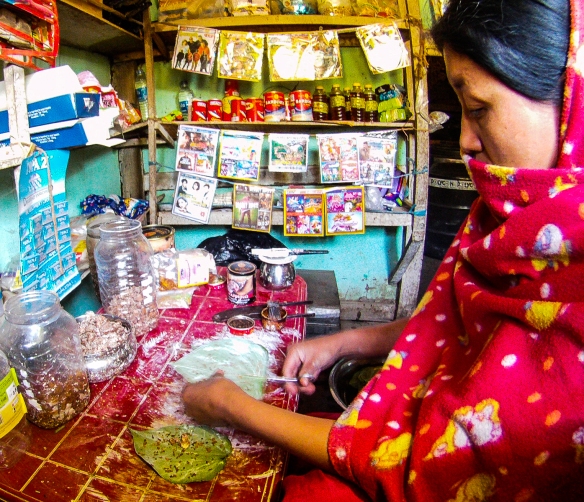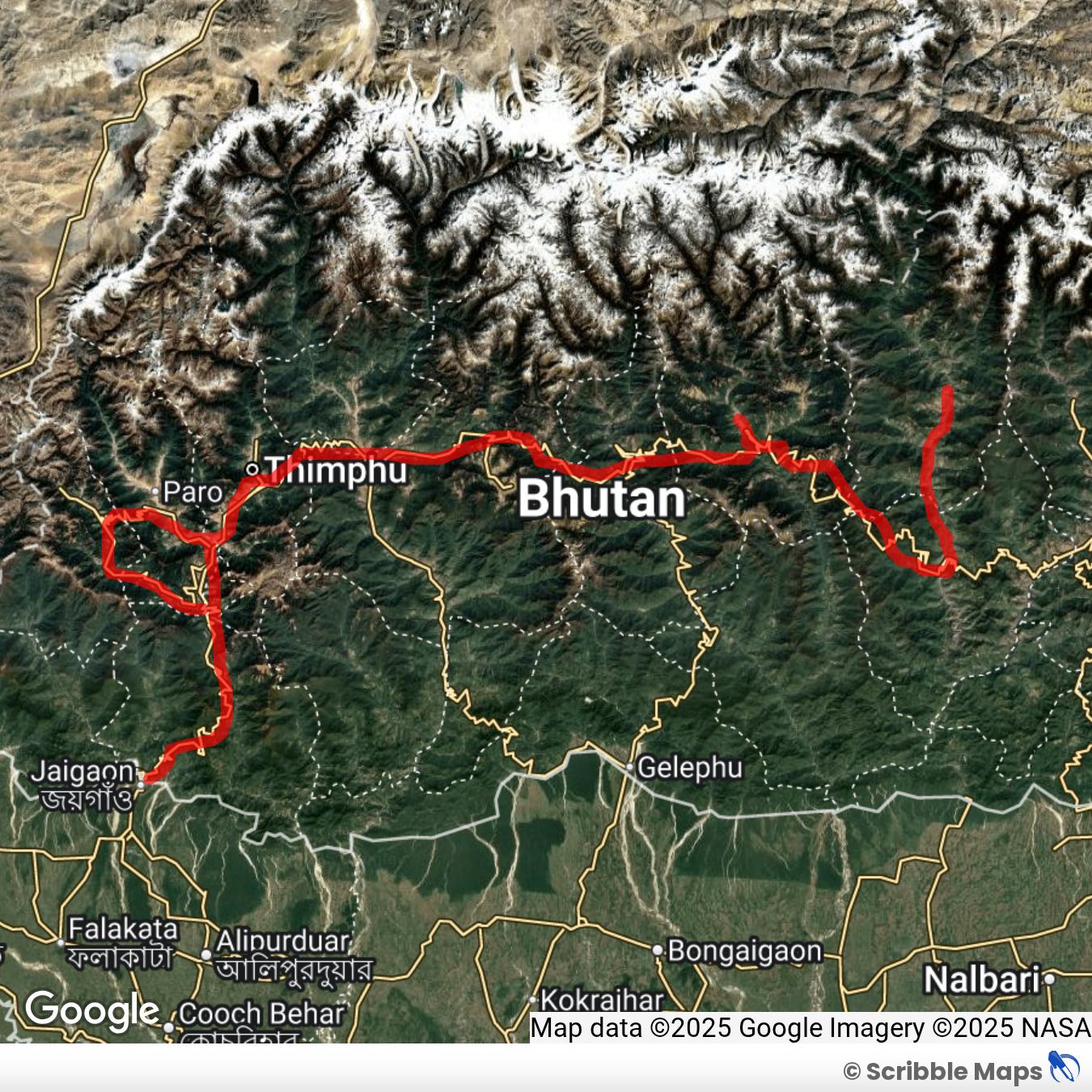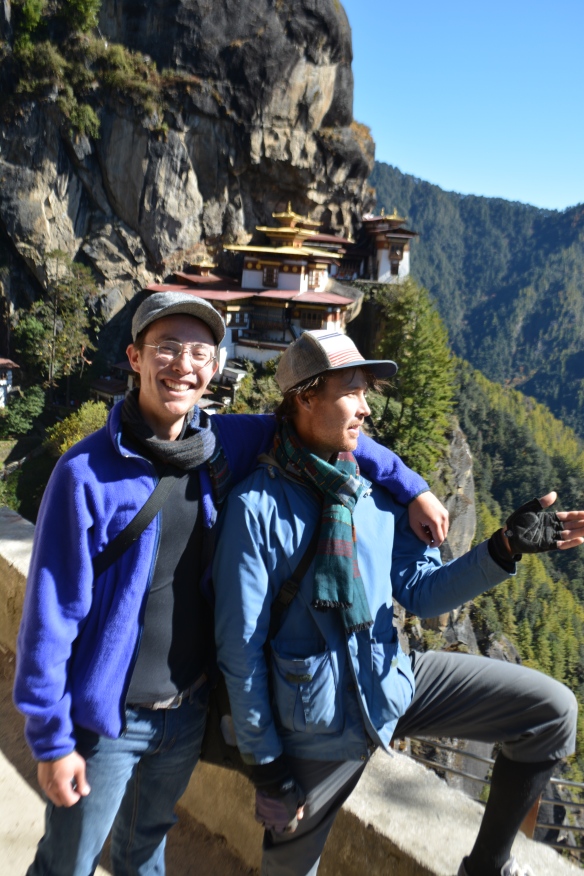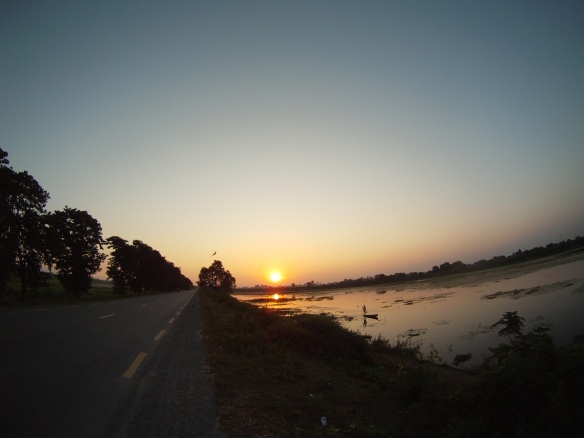
Under a hot sun, traffic, trash, cows and noise for miles.
India is by far the most difficult country for cycling. The traffic alone would scare most from taking the streets on a two wheeler, combined with the summer heat, pollution, terrible road conditions and masses of people you get an experience like no other. India is a world of its own, unique and always surprising.

Girl wandering through traffic looking for Indian Rupees.

Food stalls on the Ganga river, Rishikesh
My first impression was absolute chaos as I made my way through rush hour on a muddy, dirt road packed with vehicles. Motorcycles zipped through, cows blocked lanes napping in the shade, beggars tapped on windows seeking food, and cow shit…. everywhere. Meanwhile the sun burns through the clouds and temperatures sore, the humidity is 100% and every gas powered vehicle around you is honking. The locals have become so accustomed to the noise that it no longer seems to bother them, and I find that they rarely look before crossing the street. Without a bell or a horn this makes things extremely difficult as I often have to yell to keep people from crossing the road in front of me.

Everyone seems o be wearing a Turban here, but there are very few Muslims.

Things get better with altitude, Dharamshala 6,000 feet

Temple of the Dali Lama, Dharamshala is his official residence away from Tibet.
It is quite shocking. Cities consist of miles of traffic, with shanty towns built out of cardboard and plastic along the river. Everywhere you go a holy building, be it a Muslim Mosque, Hindu Ashram or Sikh Gurdwara peaks out of sprawl and can be seen from a distance. Devotional music (Kirtan) played on harmonium, tabla, bell and voice echos through speakers in grocery stores, gas stations and pharmacies. Hindu ascetics, with long beards, dreaded hair and long orange robes walk the streets barefoot seeking alms.

Sikh Gurdwara, Langaar, meal time

Women rolling dough for deep fried Puri
Within all this I have found sanctuary in the Sikh temples known as Gurdwaras. Here travelers are welcomed and given a safe place to sleep as well as an evening meal free of charge. The Sikhs are often surprised to see a foreigner on a bicycle but quickly invite me in, often times giving me a room to sleep in. The Gurdwaras are usually large cylindrical white domes easily seen from a far, upon entering your head is covered with a turban or bandanna and feet and hands are washed before entering the main hall. Inside the main hall a holy text called the Gurbani is placed on a table covered in bright cloth.

New Sikh friends.
Religious Sikhs forego cutting their hair, as it is regarded as holy. Men and women cover their extremely long hair with a turban (white, yellow and orange being the norm) or shawl and always carry a small sword or knife called a Kirpaan at their side. Men often tuck their extremely long beards into their turban. Their practice includes reciting the Gurbani, playing and singing Kirtan, and prayer. I have found them to be generous, kind and honest. I often look for Sikh businesses as they will not inflate the price for a foreign customer.

Public water fountain
Everywhere else bargaining is a must! Fruits and vegetables are all purchased on small roadside carts. My first day I was charged double for everything, still thinking prices were cheap. A kilo of eggplant costs $0.50, tomatoes $0.20 and onions $0.10. Local food is abundant yet monotonous. Breakfast is some sort of toasted bread, or scone with a cup of super sweet milk chai, lunch and dinner consist of chapatis (whole wheat tortillas), Dal (Legume pulse with spice), mush boiled vegetables, and white rice (Basmati). To get good vegetables and ample protein I have to cook for myself, boiling eggs and mixing Dal with eggplant. Yogurt has become my go to during hot afternoons when I am hungry but can not take the rich Indian diet. The locals have quite a sweet tooth, with shops selling sweet fried dough balls, and Chai, Coffee and black tea always being loaded with sugar. As a result the typical Indian body has small legs, skinny arms and a large belly. On hot afternoons you can see Indians eating buttered chapatis and rich curries in the shade of a small restaurant. To me their diet caters more to a cold atmosphere, rather than the tropical. I miss the sticky rice, bamboo shoots and roasted meats of Laos.

Huge batch of Choley. spiced Chickpeas
Everyday is a sensory overload, with smells of spice, composting waste, incense, smog, and sweat. In cities and towns I often find myself surrounded by locals touching my bicycle, pulling on panniers, and grabbing brake levers. Disheveled kids often chase me down small streets and catch me before I enter busy intersections. There is no doubt to me that India is by far the most challenging, but there is also much to offer in culture, religion and history.
I am now in the holy city of Rishikesh, made famous to west by the Beatles trip to India in the late 60’s. Foreigners travel the streets looking for Ashrams, Gurus and yoga teachers. The Nepal border is 400 km away, and I look forward to a respite from the heat, and chaos of the cities.The foothills will soon make way to the Himalayas.










 It is difficult garnering up the courage to cycle when the view outside looks like this. I spent a rough night in a Nagaland guest house with no air conditioning, and suffered the consequences of a headache and burning eyes when I left the window open for air in a city like this. This is by far one of the most polluted cities I have seen, Dimapur, Nagaland the commute hub of Nagaland. Here, trash piles fill the streets and in local markets I find stacks of rotting, unwanted meat products and fish gills. Everything is stained an orange red color from the dried spit of local chewing tobacco and the atmosphere a constant haze of burning trash, exhaust and road dust. I find it hard to imagine what life must be like for those living like this every day, and feel sorry for the children that take their first breath here. Why am I so lucky that in 6 days I can board an airplane and in less than 24 hours be in paradise, while millions of people just like me live like this?
It is difficult garnering up the courage to cycle when the view outside looks like this. I spent a rough night in a Nagaland guest house with no air conditioning, and suffered the consequences of a headache and burning eyes when I left the window open for air in a city like this. This is by far one of the most polluted cities I have seen, Dimapur, Nagaland the commute hub of Nagaland. Here, trash piles fill the streets and in local markets I find stacks of rotting, unwanted meat products and fish gills. Everything is stained an orange red color from the dried spit of local chewing tobacco and the atmosphere a constant haze of burning trash, exhaust and road dust. I find it hard to imagine what life must be like for those living like this every day, and feel sorry for the children that take their first breath here. Why am I so lucky that in 6 days I can board an airplane and in less than 24 hours be in paradise, while millions of people just like me live like this?





























































